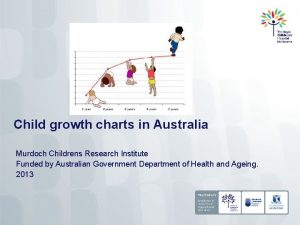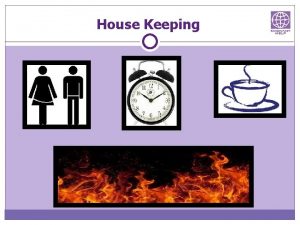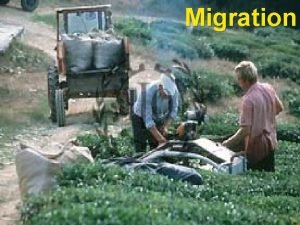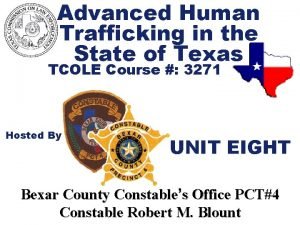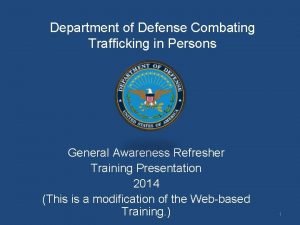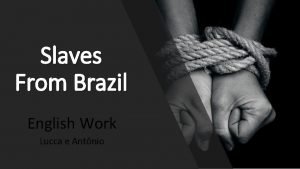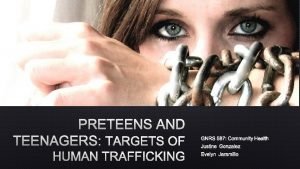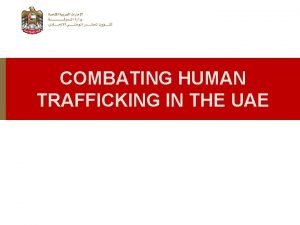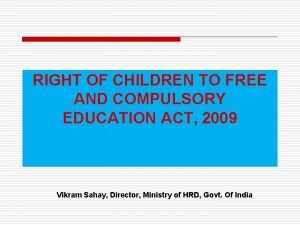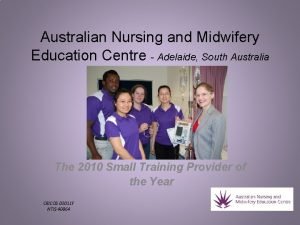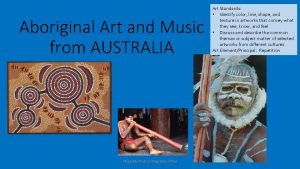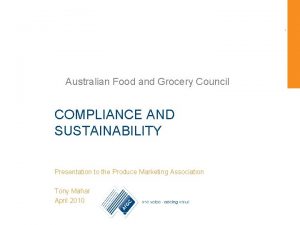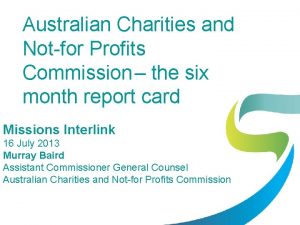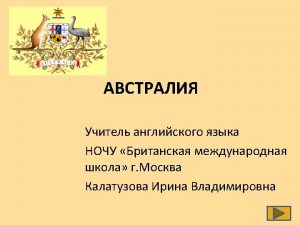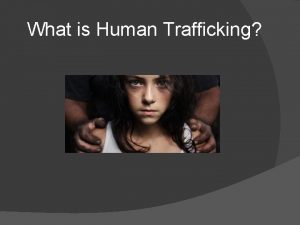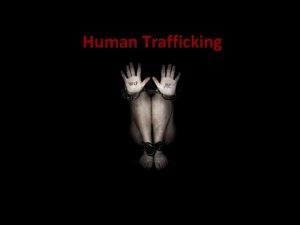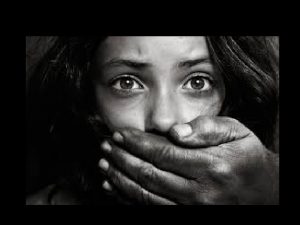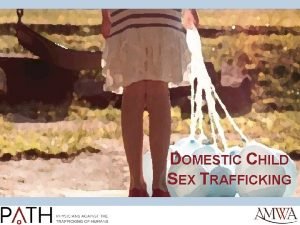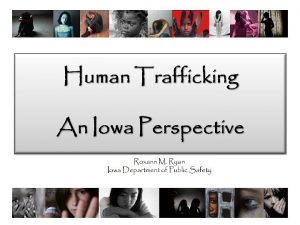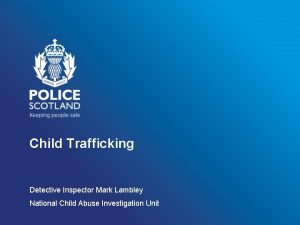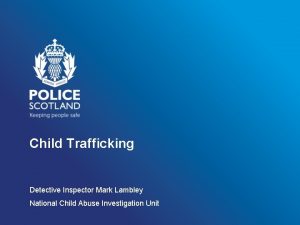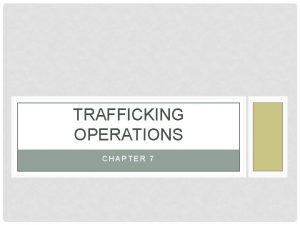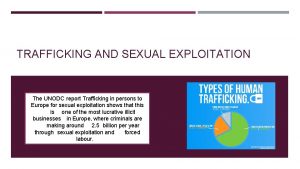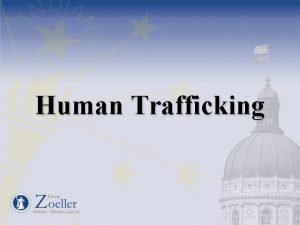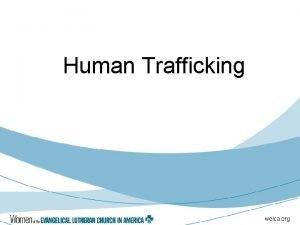CHILD TRAFFICKING and the AUSTRALIAN GEOGRAPHY CURRICULUM LP









































- Slides: 41

CHILD TRAFFICKING and the AUSTRALIAN GEOGRAPHY CURRICULUM

LP: 1 “When a little boy is kidnapped, turned into a child soldier, forced to kill or be killed—that’s slavery. When a little girl is sold by her impoverished family. . . runs away from home, or is lured by the false promises of a better life, and then imprisoned in a brothel and tortured if she resists—that’s slavery. It is barbaric, and it is evil, and it has no place in a civilized world. ” President Barack Obama, September 25 th, 2012

LP: 1 CASE STUDY Nong Tong was a 6 -year old girl living with her grandparents in northern Myanmar not far from the city of Bagan. Her parents were dead but her grandparents, though poor, loved her and took care of her as best they could. She helped her grandmother with the daily chores of fetching water, cooking and cleaning and looked forward to the day that she could go to school. One day, some of her relatives living in Myanmar’s capital city Yangon asked her grandparents for Nong Tong to come and visit them for a few weeks. She travelled by bus with one of her relatives to Yangon and was excited to see the big bustling city and was amazed by what she saw: cinemas, sealed roads and thousands of cars. But what she found most exciting was the groups of children in their school uniforms. Perhaps, she thought, this is why I have come to Yangon. Her relatives, however, had other plans for her. They soon drove her to the border and slipped illegally into neighbouring Thailand along one of the unpatrolled country roads that cross the border. Making their way to the bustling Thai city of Chiang Mai they put Nong Tong to work in a begging ring. Her job was to go out at night and beg for money in the busy markets and night bazaars where Thais and foreigners came to shop and eat. It was terrifying work as she did not speak Thai and often became lost in the confusing streets and laneways of the busy city. Even more terrifying, however, was returning to the room she shared with the other children from the begging ring.

LP: 1 CASE STUDY Like the others, she had a quota of money she had to collect every night. If she didn’t bring back enough money to the leaders of the begging ring, she was beaten by the ring leaders or refused food and sent back out to get more money. She sometimes stole money from the pockets and bags of the tourists to reach her quota and avoid the frequent beatings. The begging ring often moved from shanty to shanty in the squalid slums of Chiang Mai to avoid police detection. The years passed until Nong Tong was 15 years old. Unlike most other young girls, Nong Tong never went to school and so she couldn’t read nor write. She was up every night until 3 or 4 a. m. in the street markets begging. During the day, she would sleep a little and then have to work for the begging ring by washing clothes, cooking, and taking care of the smaller children. She couldn’t speak much Thai so she was afraid to ask anyone for help. It seemed there was no hope for her. . . Tong is part of the one of the world’s fastest growing and largest criminal activities. She is a ‘trafficked’ person who has been transported and exploited against her will. This case study is based on real life events. In an effort to protect her identity, the exact details of this case study may combine the facts of more than one case and the location may have been changed. Nong Tong is not her real name. As used in this case study, ‘Nong’ is a personal pronoun that means “young” or “child” and the child’s name is Tong.

LP: 1

LP: 1

LP: 2 ‘Human trafficking is a global problem and one of the world’s most shameful crimes, affecting the lives of millions of people around the world and robbing them of their dignity. ’ Source: United Nations Office on Drugs and Crime

LP: 2 ELEMENTS OF HUMAN TRAFFICKING

INDUSTRIES THAT MAY EXPLOIT TRAFFICKED CHILDREN LP: 2

LP: 1

LP: 1

LP: 3 ‘Child trafficking exists in all countries. ’ Source: UNICEF report on child trafficking in East and South-East Asia

LP: 3 MODERN SLAVERY IN SOUTH-EAST ASIA

LP: 3 CHILD TRAFFICKING & AUSTRALIANS Child trafficking is rare in Australia although several cases of children trafficked from Thailand to work in Australian brothels have been prosecuted in Australian courts. This does not mean, however, that Australians are not involved in child trafficking in other places. A Sydney Morning Herald report in 2008 (see ‘Resources’ section) reported that almost 100, 000 Australian men travel to Thailand each year for the purpose of sex. It also reported that the average for a girl entering the Thai sex industry to be 14 and that most girls are aged between 12 and 16. The article states that ‘this results in children being either kidnapped or sold into the trade, either knowingly or unwittingly, by their families. ’

LP: 1

LP: 1

LP: 4 Child trafficking is similar to other economic enterprises such as a clothes shop or fast-food chain. It exists because there is both supply and demand. There is a supply of children who are vulnerable to being trafficked and there is a demand for the services that children are forced to provide such as cheap or free labour and sexual services.

There is no one reason why children are trafficked but there are many factors that make some children more vulnerable to this type of exploitation than other children. A combination of factors increased a child’s vulnerability. UNICEF report into child trafficking in East and South. East. LP: 4

LP: 1

LP: 1

LP: 5 Child trafficking, like slavery, dates back many hundreds of years but efforts to combat it before 2000 were not widespread. In the last few years, however, there has been a significant increase in public awareness of this issue around the world and a growth in the numbers of individuals and organisations dedicated to ending this practice.

LP: 5 A GLOBAL RESPONSE: THE UNITED NATIONS The United Nations was formed in 1945 in the aftermath of World War Two to promote international cooperation and to prevent future wars. Virtually all countries of the world including Australia and Thailand are members of the United Nations. In 2000, the United Nations adopted the ‘Protocol to Prevent, Suppress and Punish Trafficking in Persons, especially Women and Children, ’ also known as the Palermo Protocol. Countries who signed the Protocol agreed that child trafficking is illegal and traffickers should be punished, even if they are family members of the trafficked child. While most countries have signed up to the Protocol, 29 have not.

LP: 5 NATIONAL RESPONSE: AUSTRALIA The Australian government has signed the United Nations Protocols in relation to human trafficking. In 2003 they adopted a strategy to help end trafficking and since then have spent $150 million to support various strategies. These include specialist anti-trafficking units in the Australian Federal Police and programmes to support victims of trafficking. The Australian Government is also committed to ending the involvement of Australians in the exploitation of children when they travel overseas. From 1995 ‘Australians who commit child sex offences while overseas can be investigated and prosecuted under Australian law. ’ (Source: Smart Traveller website).

LP: 5 NATIONAL RESPONSE: THAILAND In 2013, the Thai government allotted $6. 1 million to conduct anti-trafficking efforts. The police reported investigating 674 trafficking cases and the government reported convicting 225 traffickers. Amongst its recommendations to the Thai government, the US State Department urged that Thailand ‘recognize the valuable role of NGOs in uncovering the nature and scope of human trafficking in Thailand. ’

LP: 5 NON-GOVERNMENT ORGANIZATIONS: NGO’s There are many NGOs that work in the area of child trafficking. Some focus on victim identification, rescue and support; some on pressuring governments to do more to fight this crime; others on raising public awareness. Some of these NGOs are: • ZOE • Trafcord • Compassion Australia • MTV Exit • Polaris Project • International Justice Mission (IJM) • End Child Prostitution, Child Pornography And Trafficking of Children for Sexual Purposes (ECPAT)

LP: 5 CASE STUDY OF AN NGO Since 2003, ZOE has provided safety and shelter for orphans, children deemed to be highly at risk of trafficking by ZOE’s Child Rescue Department, and children rescued directly from slavery. Through effective partnerships with governments and law enforcement, ZOE helps trafficked children in South-East Asia find safety and freedom. Some rescued children can be reunited to families after a short Children’s Homes northern Thailand long-term. stay at ZOE, while in others will live at ZOEZOE also travels to remote areas of Thailand border regions to provide the education and assistance to vulnerable people groups.

LP: 5

LP: 5 WHAT YOU CAN DO TO END CHILD TRAFFICKING! If you think that there is little that you can do in response to an issue such as child trafficking you are mistaken. There are many things that you can do. Just by completing this unit you have already done something! You are now aware of the issue, what you do next is up to you. Perhaps one of the simplest things you can do is to use your power as a consumer. Remember that child trafficking exists because there is a demand for the services that children are forced to provide. Try to find out where things you buy are made and who makes them. This is known as the supply chain. Don’t buy items made by companies that use child labour. This can be difficult to find out but it’s not impossible. Start with the Free 2 Work website which ranks hundreds of companies on the efforts they have made to make sure they don’t use child or forced labour. Become an ethical consumer!

LP: 1

LP: 1

LP: 6 Remember Nong Tong who was trafficked into a begging ring in Chiang Mai? Here is Part 2 of her story. (You may like to re-read Part 1 first)

LP: 6 CASE STUDY: Part 1 Nong Tong was a 6 -year old girl living with her grandparents in northern Myanmar not far from the city of Bagan. Her parents were dead but her grandparents, though poor, loved her and took care of her as best they could. She helped her grandmother with the daily chores of fetching water, cooking and cleaning and looked forward to the day that she could go to school. One day, some of her relatives living in Myanmar’s capital city Yangon asked her grandparents for Nong Tong to come and visit them for a few weeks. She travelled by bus with one of her relatives to Yangon and was excited to see the big bustling city and was amazed by what she saw: cinemas, sealed roads and thousands of cars. But what she found most exciting was the groups of children in their school uniforms. Perhaps, she thought, this is why I have come to Yangon. Her relatives, however, had other plans for her. They soon drove her to the border and slipped illegally into neighbouring Thailand along one of the unpatrolled country roads that cross the border. Making their way to the bustling Thai city of Chiang Mai they put Nong Tong to work in a begging ring. Her job was to go out at night and beg for money in the busy markets and night bazaars where Thais and foreigners came to shop and eat. It was terrifying work as she did not speak Thai and often became lost in the confusing streets and laneways of the busy city. Even more terrifying, however, was returning to the room she shared with the other children from the begging ring.

LP: 6 CASE STUDY: Part 1 Like the others, she had a quota of money she had to collect every night. If she didn’t bring back enough money to the leaders of the begging ring, she was beaten by the ring leaders or refused food and sent back out to get more money. She sometimes stole money from the pockets and bags of the tourists to reach her quota and avoid the frequent beatings. The begging ring often moved from shanty to shanty in the squalid slums of Chiang Mai to avoid police detection. The years passed until Nong Tong was 15 years old. Unlike most other young girls, Nong Tong never went to school and so she couldn’t read nor write. She was up every night until 3 or 4 a. m. in the street markets begging. During the day, she would sleep a little and then have to work for the begging ring by washing clothes, cooking, and taking care of the smaller children. She couldn’t speak much Thai so she was afraid to ask anyone for help. It seemed there was no hope for her. . . Tong is part of the one of the world’s fastest growing and largest criminal activities. She is a ‘trafficked’ person who has been transported and exploited against her will. This case study is based on real life events. In an effort to protect her identity, the exact details of this case study may combine the facts of more than one case and the location may have been changed. Nong Tong is not her real name. As used in this case study, ‘Nong’ is a personal pronoun that means “young” or “child” and the child’s name is Tong.

LP: 6 CASE STUDY: Part 2 But then Nong Tong heard the rumours. There whispers on the street amongst the street kids – the trafficked children – that there was a place that took care of children just like her and, if she could get there, she would be safe. She thought it was just a fairy tale, something other kids dreamed up in their imagination. She didn’t believe it was a real place. But still it comforted her. It made her feel better. It gave her a glimmer of hope. She would often dream about this place as she lay on her mat, tired and hungry. One night the traffickers told the children that there were people in a certain section of town looking for them and they told them, “Don’t go anywhere near that place! If you do, the police will arrest you and throw you in prison. ” The traffickers threatened the children with a beating or worse. But something told Nong Tong that this was her chance for a better life. Despite the risks and the danger of a severe beating she sneaked through the laneways to the forbidden part of town and made a run for freedom into the arms of a child rescue team. At first she was anxious about being handed over to the police or worse, being taken back to her captors but the team quickly let her know that her long nightmare was finally over.

LP: 6 CASE STUDY: Part 2 She was taken to the ZOE Children’s Home, a large home that looked like a tourist resort to Nong Tong. It sits on 20 acres of beautiful land in the lush mountains of Thailand about an hour from Chiang Mai. There, she joined the 60 other children who had been rescued from human trafficking or who had been at-risk or orphans. During her first week at the home, Nong Tong walked around in a daze wondering, “So this is the place that was created just for kids like me? I can’t believe it’s real!” With the help of teachers at the home, Nong Tong learned to read and write and to speak Thai. For the first time in her life, she went to a real school. She was so hungry to learn that she excelled in class, rapidly advancing from grade 1 to year 7. She also discovered passions for sewing and language, quickly learning how to make clothes and to speak English fluently. Finally she felt safe, free and happy but her story was far from over. The gang that ran the begging ring had been arrested by the police and several of them were about to come to trial. Nong Tong was asked to be a witness in the trial and to tell her story to the court. At first she felt scared and nervous about the possibility of seeing these men and women again but with the support of the ZOE staff she built up the courage to testify in court. Based in part on her testimony, the perpetrators were sentenced to 15 years in prison.

LP: 6 CASE STUDY: Part 2 After 3 years at the children’s home, another amazing thing happened in Nong Tong’s life. The ZOE child rescue team discovered that Nong Tong’s grandparents were still alive and located the general area where they lived. A team of investigators went to Myanmar to track them down and to find out whether they were willing and able to care for Nong Tong. When the team arrived in the small village, they found the grandparents’ home. With the help of a translator, they explained why they had come. When team members showed photographs of Nong Tong, the grandmother burst into tears of joy. She had long since believed that her precious granddaughter was dead, having not heard anything from her since the day she went away twelve years before to visit the other relatives “for a few weeks. ” After determining that the grandparents were able and willing to take good care of Nong Tong, the child rescue team went back to Thailand and, a few weeks later, took Nong Tong to Myanmar and reunited her with her family. In fact, the entire village came out to rejoice in the return of their long-lost daughter! This case study is based on real life events. In an effort to protect her identity, the exact details of this case study may combine the facts of more than one case and the location may have been changed. Nong Tong is not her real name. As used in this case study, ‘Nong’ is a personal pronoun that means “young” or “child” and the child’s name is Tong.

PHOTOGRAPHS FROM ZOE CHILDREN’S HOME LP: 6

PHOTOGRAPHS FROM ZOE CHILDREN’S HOME LP: 6

PHOTOGRAPHS FROM ZOE CHILDREN’S HOME LP: 6

LP: 1

LP: 1
 Murdoch pie chart
Murdoch pie chart Information and communication technology capability
Information and communication technology capability Literacy learning progressions
Literacy learning progressions Australian curriculum framework for junior doctors
Australian curriculum framework for junior doctors Australian curriculum lessons
Australian curriculum lessons Australian curriculum hpe
Australian curriculum hpe Australian curriculum technology
Australian curriculum technology Aims and objectives of human trafficking
Aims and objectives of human trafficking Advanced human trafficking #3271 test answers
Advanced human trafficking #3271 test answers Infested
Infested Ctip clause that must be included in every contract
Ctip clause that must be included in every contract Human trafficking map
Human trafficking map 3271 advanced human trafficking
3271 advanced human trafficking What is trafficking in persons
What is trafficking in persons Human trafficking
Human trafficking Human trafficking definition
Human trafficking definition Human trafficking
Human trafficking Combating human trafficking in the uae
Combating human trafficking in the uae 3271 advanced human trafficking
3271 advanced human trafficking Left child right child tree representation
Left child right child tree representation Right of children to free and compulsory education
Right of children to free and compulsory education Elderly support ratio definition ap human geography
Elderly support ratio definition ap human geography Australian teacher performance and development framework
Australian teacher performance and development framework New zealand accent vowels
New zealand accent vowels Australian standards for texture modified foods and fluids
Australian standards for texture modified foods and fluids Anmec
Anmec Australian aboriginal art and music
Australian aboriginal art and music Australian food and grocery council
Australian food and grocery council Australian charities and not-for-profits commission
Australian charities and not-for-profits commission Aboriginal art symbols
Aboriginal art symbols An australian billabong and a texan
An australian billabong and a texan How to write an frq for ap human geography
How to write an frq for ap human geography 5 themes of geography ap human geography
5 themes of geography ap human geography Stateless nation
Stateless nation Hát kết hợp bộ gõ cơ thể
Hát kết hợp bộ gõ cơ thể Ng-html
Ng-html Bổ thể
Bổ thể Tỉ lệ cơ thể trẻ em
Tỉ lệ cơ thể trẻ em Gấu đi như thế nào
Gấu đi như thế nào Tư thế worm breton là gì
Tư thế worm breton là gì Bài hát chúa yêu trần thế alleluia
Bài hát chúa yêu trần thế alleluia Môn thể thao bắt đầu bằng từ đua
Môn thể thao bắt đầu bằng từ đua
